The MPLS-based Core Network Market is estimated to be valued at USD 55.0 billion in 2025 and is projected to reach USD 143.9 billion by 2035, registering a compound annual growth rate (CAGR) of 10.1% over the forecast period.
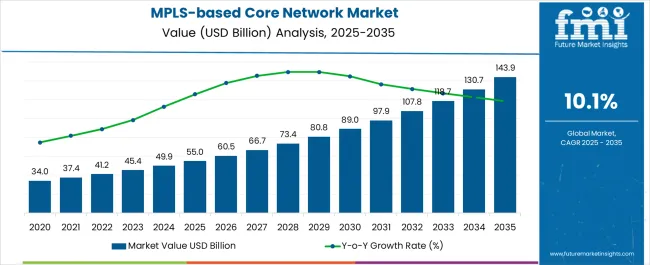
| Metric | Value |
|---|---|
| MPLS-based Core Network Market Estimated Value in (2025E) | USD 55.0 billion |
| MPLS-based Core Network Market Forecast Value in (2035F) | USD 143.9 billion |
| Forecast CAGR (2025 to 2035) | 10.1% |
The MPLS based core network market is experiencing steady growth driven by rising data traffic volumes, increased adoption of cloud services, and the need for highly reliable and secure communication infrastructures. Enterprises are increasingly focused on scalable networking frameworks that can support mission critical applications, lower latency, and seamless multi site connectivity.
MPLS has remained central to enterprise and service provider strategies as it offers predictable performance, traffic engineering capabilities, and strong quality of service mechanisms. Regulatory compliance in sectors like banking and finance is further reinforcing the adoption of MPLS based networking to ensure data security and uninterrupted service delivery.
The outlook remains positive as hybrid networking approaches that integrate MPLS with SD WAN are gaining momentum, allowing enterprises to balance flexibility with performance. Continuous investments in network modernization and demand for robust backbone infrastructure are expected to sustain market expansion over the coming years.
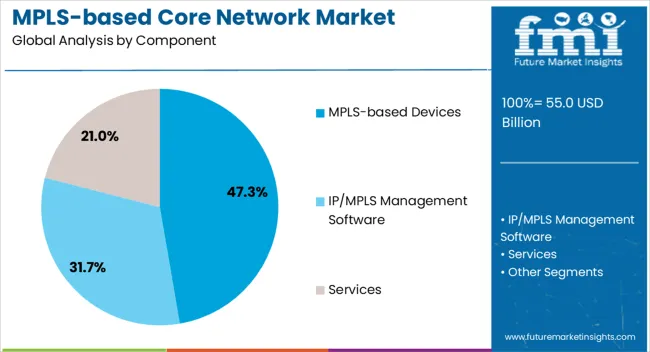
The MPLS based devices segment is expected to account for 47.30% of total market revenue by 2025, making it the dominant component category. Growth in this segment is supported by increasing enterprise demand for efficient packet forwarding, enhanced bandwidth utilization, and seamless integration with legacy systems.
The devices have been widely deployed across data centers and enterprise networks due to their ability to manage complex traffic patterns with high reliability. Furthermore, the need to support advanced applications, secure financial transactions, and large scale communication requirements has strengthened the role of MPLS based devices.
Continuous innovation and vendor focus on cost effective yet high performance devices are further reinforcing the leadership of this component segment.
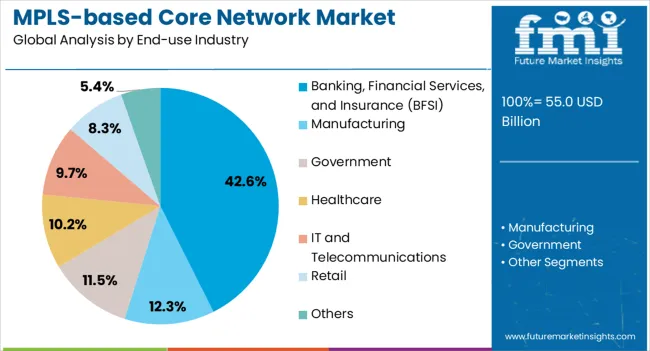
The banking financial services and insurance segment is projected to hold 42.60% of total revenue within the end use industry category by 2025, making it the leading vertical. This dominance is attributed to the sector’s high reliance on secure, low latency, and resilient networking infrastructures.
Financial institutions require uninterrupted connectivity to support real time transaction processing, data security, and compliance with stringent regulatory frameworks. MPLS based networks have been adopted extensively in this industry due to their ability to deliver predictable performance and guarantee quality of service for critical operations.
Additionally, rising digital banking adoption, fintech expansion, and the global shift toward online financial services are driving further reliance on MPLS infrastructure. As a result, the BFSI segment continues to reinforce its position as the primary driver of growth within the MPLS based core network market.
Increasing demand for managed MPLS-based core networks that can provide excellent quality of service to avoid packet loss is expected to propel demand over the coming years.
The market is projected to witness significant growth due to several factors such as the growing need for reliable and cost-effective MPLS-based core network, improved network utilization, increasing core network providers landscape, and rising availability of cost-effective MPLS-based core networks along with technological advancements.
The MPLS-based core network market was valued at nearly USD 40 Billlion in 2024 and is expected to grow at a CAGR of 10% during the forecast period 2024 to 2035.
Growth in developments of mobile backhaul networks across various enterprises can enable mobile operators to provide network visibility to their clients while also bringing them the same operational and engineering benefits. Significant growth in the MPLS-based core network technology is expected to lead to greater opportunities for the mobile service providers and wholesale operators to enhance backhaul infrastructure.
There is an increasing demand for secure connectivity for various end-users such as IT & telecommunications, BFSI, healthcare, and others for data management, which is one of the major factors fueling demand for MPLS-based core networks across regions. It offers various features such as secure, flexible, and scalable network connectivity. The reliability of such features drives the demand for the MPLS-based core network technology.
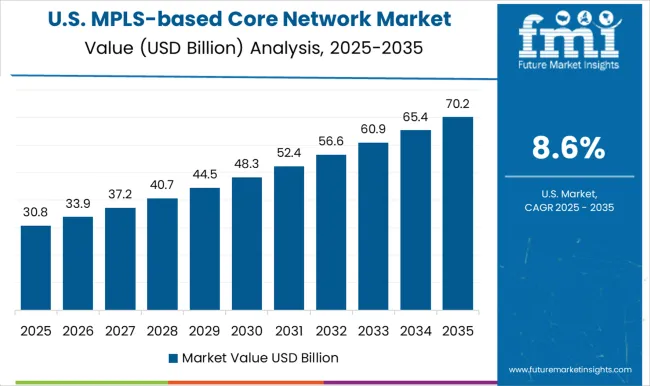
The USA is one of the largest markets for MPLS-based core networks globally. The USA MPLS-based core network market is set to tread on the historic pattern of bust and boom during the assessment period 2025 to 2035. Demand is likely to remain muted in the next couple of years, as several end-use industries make a gradual recovery.
Demand for MPLS-based core networks in the USA and Canada will be LED by the IT and telecom sectors. Furthermore, the widespread investments in cloud services due to the superior advantages of IaaS, SaaS, and PaaS and to maintain their delivery with a hybrid solution, in turn, is fueling the growth of the MPLS-based core network in the USA and Canada region.
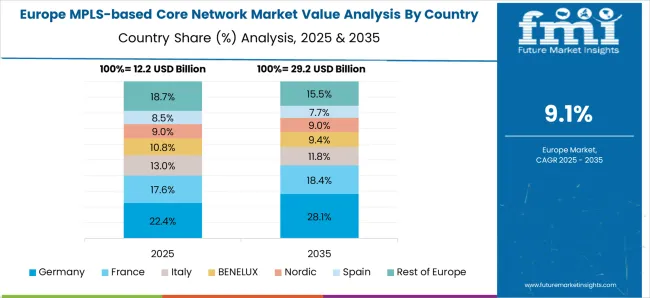
The adoption of MPLS network components is expected to rise considerably across small- and medium-sized businesses in Germany, the UK, France, Spain and Eastern European countries as well. Demand for MPLS-based core network technologies is increasing due to the increasing focus on cloud computing and expanding secure networking among enterprises across Europe.
Some of the key players such as Deutsche Telekom AG, Cisco Systems Inc., Nokia, Orange S.A., and others are focused on securing and offering advanced solutions for IP MPLS core networks, that have the potential to enhancing customer experience, while increasing their profitability in European countries. Europe is identified as the second-leading market, a position it is likely to hold on to through the forecast period.
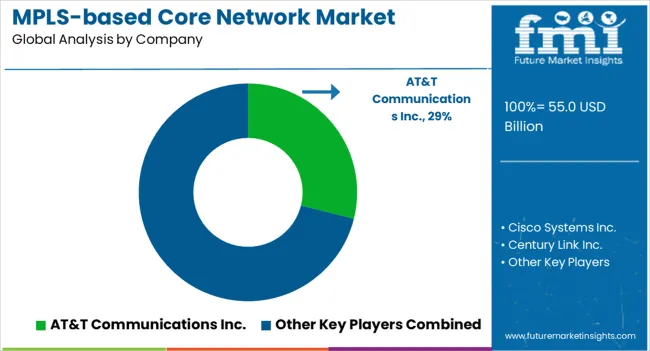
Some of the leading providers of MPLS-based core network include
The MPLS-based core network provider’s major strategy involves expansion through the collaboration of assets, business, technologies, and products that allow them for business expansion and gain significant market shares. For instance, in September 2024, AT&T partnered with DriveNets, to utilize DriveNets Network Cloud for deploying their next gen IP/MPLS core routing solution in the US.
The report is a compilation of first-hand information, qualitative and quantitative assessment by industry analysts, inputs from industry experts and industry participants across the value chain. The report provides in-depth analysis of parent market trends, macro-economic indicators and governing factors along with market attractiveness as per segments.
The report also maps the qualitative impact of various market factors on market segments and geographies.
The global MPLS-based core network market is estimated to be valued at USD 55.0 billion in 2025.
The market size for the MPLS-based core network market is projected to reach USD 143.9 billion by 2035.
The MPLS-based core network market is expected to grow at a 10.1% CAGR between 2025 and 2035.
The key product types in MPLS-based core network market are MPLS-based devices, ip/MPLS management software and services.
In terms of end-use industry, banking, financial services, and insurance (bfsi) segment to command 42.6% share in the MPLS-based core network market in 2025.






Our Research Products

The "Full Research Suite" delivers actionable market intel, deep dives on markets or technologies, so clients act faster, cut risk, and unlock growth.

The Leaderboard benchmarks and ranks top vendors, classifying them as Established Leaders, Leading Challengers, or Disruptors & Challengers.

Locates where complements amplify value and substitutes erode it, forecasting net impact by horizon

We deliver granular, decision-grade intel: market sizing, 5-year forecasts, pricing, adoption, usage, revenue, and operational KPIs—plus competitor tracking, regulation, and value chains—across 60 countries broadly.

Spot the shifts before they hit your P&L. We track inflection points, adoption curves, pricing moves, and ecosystem plays to show where demand is heading, why it is changing, and what to do next across high-growth markets and disruptive tech

Real-time reads of user behavior. We track shifting priorities, perceptions of today’s and next-gen services, and provider experience, then pace how fast tech moves from trial to adoption, blending buyer, consumer, and channel inputs with social signals (#WhySwitch, #UX).

Partner with our analyst team to build a custom report designed around your business priorities. From analysing market trends to assessing competitors or crafting bespoke datasets, we tailor insights to your needs.
Supplier Intelligence
Discovery & Profiling
Capacity & Footprint
Performance & Risk
Compliance & Governance
Commercial Readiness
Who Supplies Whom
Scorecards & Shortlists
Playbooks & Docs
Category Intelligence
Definition & Scope
Demand & Use Cases
Cost Drivers
Market Structure
Supply Chain Map
Trade & Policy
Operating Norms
Deliverables
Buyer Intelligence
Account Basics
Spend & Scope
Procurement Model
Vendor Requirements
Terms & Policies
Entry Strategy
Pain Points & Triggers
Outputs
Pricing Analysis
Benchmarks
Trends
Should-Cost
Indexation
Landed Cost
Commercial Terms
Deliverables
Brand Analysis
Positioning & Value Prop
Share & Presence
Customer Evidence
Go-to-Market
Digital & Reputation
Compliance & Trust
KPIs & Gaps
Outputs
Full Research Suite comprises of:
Market outlook & trends analysis
Interviews & case studies
Strategic recommendations
Vendor profiles & capabilities analysis
5-year forecasts
8 regions and 60+ country-level data splits
Market segment data splits
12 months of continuous data updates
DELIVERED AS:
PDF EXCEL ONLINE
Core Plate Varnishes Market Size and Share Forecast Outlook 2025 to 2035
Core Drill Automatic Feeding Machine Market
Core Banking Solution Market Report – Growth & Forecast 2017-2027
Woodcore Access Floor Market Size and Share Forecast Outlook 2025 to 2035
Air Core Fixed Shunt Reactor Market Size and Share Forecast Outlook 2025 to 2035
Air Core Variable Shunt Reactor Market Size and Share Forecast Outlook 2025 to 2035
Multicore Cables Market
Paper Core Market Size and Share Forecast Outlook 2025 to 2035
Paper Core Cutting Machine Market Size and Share Forecast Outlook 2025 to 2035
Multi Core Armored Cable Market Size and Share Forecast Outlook 2025 to 2035
Shell Core Transformer Market Size and Share Forecast Outlook 2025 to 2035
Berry Core Power Transformer Market Size and Share Forecast Outlook 2025 to 2035
Industry Share Analysis for Paper Core Companies
Single Core Armored Cable Market Size and Share Forecast Outlook 2025 to 2035
Closed Core Power Transformer Market Size and Share Forecast Outlook 2025 to 2035
LCD TV Core Chip Market Size and Share Forecast Outlook 2025 to 2035
Closed Core Transformer Market Size and Share Forecast Outlook 2025 to 2035
Hollow Core Slab Extruder Market Analysis - Size, Share, and Forecast Outlook 2025 to 2035
Laser Scored Bags Market
Single Core Cables Market

Thank you!
You will receive an email from our Business Development Manager. Please be sure to check your SPAM/JUNK folder too.
Chat With
MaRIA